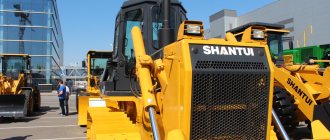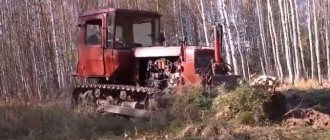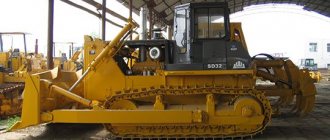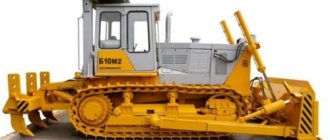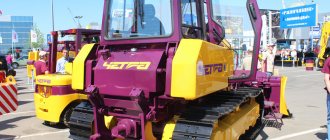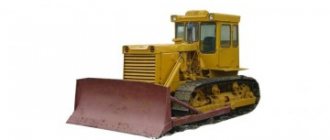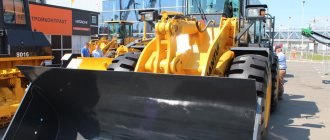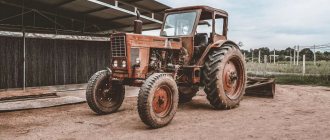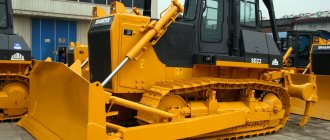The Chinese bulldozer Shantui SD-16 is very similar in appearance to the Chelyabinsk tractor T-170 (B-10). In addition, the Shantui bulldozer is comparatively cheaper than similar equipment from Caterpillar and Komatsu. And let’s also add that the Shantui bulldozer is structurally developed based on Komatsu technologies. For example, the running systems of many similar Komatsu and Shantui bulldozers are identical.
According to reviews, the Shantui bulldozer is quite reliable in operation. What “breaks” on this car is most often the chassis system and engine components. Shantui bulldozers are equipped with Shanghai and Weichai engines, developed under licenses from Japanese and American companies. In some cases, it is more economical to buy a Shantui bulldozer than, for example, a ChTZ or CHETRA bulldozer. In recent years, the Chinese Shantui bulldozer has been actively ousting domestic equipment from the market. And only the rise in the dollar exchange rate and the introduction of duties on the import of equipment by the Russian state stopped this expansion.
If your fleet already has Shantui bulldozers, then you probably know its strengths and weaknesses better than anyone and buy spare parts for its repair. But, of course, since the Shantui bulldozer is equipment from a foreign manufacturer, there are always questions in the selection and purchase of spare parts. In this note, we will try to answer one of these questions, namely, share our experience of how to choose tracks for a Shantui SD-16 bulldozer at minimal cost.
Features of the running system of Shantui bulldozers
There are currently more than 20 types of Shantui bulldozers produced in China. In Russia, the most popular modifications of bulldozers are Shantui SD-16, SD-22, SD-32. Each modification of the Shantui bulldozer is equipped with tracks with a certain shoe width, number of track chain links and link pitch.
Shantui bulldozers are available in track widths from 1450 to 2260 mm. Shantui tracks also come with shoe widths from 460 to 1100 mm, depending on the modification of the machine. Shantui tracks also have a run-up in the pitch of the track chain link from 154.25 to 260 mm.
But most often, the pitch of the track chain link is 203 mm. This means that for Shantui SD-16 bulldozers, which have tracks with a link pitch of 203 mm, you can order analogues from Russian manufacturers at lower prices. The number of links (shoes) on the Shantui SD-16 track can be from 37 to 42. The width of the shoe varies from 510 to 910 mm. Different profiles of track shoes are used, including triangular ones.
Various modifications of Shantui SD-16 tracks are used in rocky terrain, coal mines, swamps, landfills and deserts.
Among the main modifications of the Shantui SD-16 bulldozers, we note the SD-16C (coal version), SD-16F (modification with forest protection, complemented by a flat shoe with a flange), SD-16L (swamp shoe with a triangular shoe) and SD-16R (modification with a wide triangular shoe). shoe), as well as the basic model SD-16 (37-link track with a shoe width of 510 mm).
What is the main difference between the running system of the Shantui bulldozer? The chassis of the Shantui bulldozer is a floating type design. Elastic buffers are used to connect the bulldozer frame and road wheels. This reduces wear on chassis parts and increases the effort on attachments.
How to choose the right Shantui caterpillar?
One of the main problems when selecting Shantui SD-16 tracks is that often the coordinates of the running tracks of the track chain links of one manufacturer may not coincide with the dimensions of the running tracks of the rollers and idler wheels of another manufacturer. That is, simply put, the caterpillar does not “stand” on the rollers and wheels. Or, when purchasing shoes and track chains from different suppliers, it may also turn out that the mounting coordinates of the shoes do not match the mounting coordinates of the track chains. In this case, you will not be able to assemble the caterpillar. Why is this happening?
This is due to the fact that in China, several dozen enterprises are engaged in the production of parts for running systems for Shantui bulldozers. In addition, the Cheboksary Aggregate Plant produces tracks, track chains, rollers and wheels of its own design, which differs in coordinates and dimensions from similar Chinese products. This is done so that you buy the entire Shantui bulldozer running system, and not its individual components or components. All this brings confusion to the Shantui SD-16 spare parts market.
To select a Shantui track, first of all, you need to know the modification of the Shantui SD-16 bulldozer, namely: track width, link pitch, shoe width and the number of links in the track chain. If you do not know all of the above parameters, then name the modification of the Shantui bulldozer, and specialists will select the necessary caterpillar for you. But in this case, there will be a risk that when installed on the bulldozer, the parts of the running system will not match each other in size. What to do?
When ordering parts for the running systems of Shantui bulldozers, be sure to specify the coordinates of the shoes, the dimensions of the roller treads and draw up a parts measurement card. For instructions on how to correctly measure the track shoe and track chain of a Shantui SD-16 bulldozer, read here and here.
Also pay attention to the table of interchangeability of undercarriage systems of foreign-made bulldozers of traction class 10, which will help you navigate the types of Shantui SD-16 tracks.
Our technical specialists recommend that when ordering a Shantui SD-16 track, you begin by drawing up a parts measurement card. In this case, you will reduce the risks of incorrectly selecting a shoe, track chain or bulldozer track to zero.
Another important point faced when purchasing Shantui tracks is the choice of manufacturer. We will talk about this in the next paragraph of our article “How to choose a Shantui caterpillar?”
Who makes Shantui SD-16 tracks?
Today there are several dozen enterprises on the market that produce Shantui SD-16 tracks. More than 90% of Shantui tracks are manufactured in China, which is logical, since the leading factories for assembling Shantui bulldozers are also located there. There are also tracks from Russian and Korean manufacturers on the market.
Chinese Shantui caterpillars
There is serious competition within China among Shantui SD-16 track manufacturers. Shantui tracks can be purchased both factory-made and so-called “cooperative”. Hence, as you understand, there are different levels of quality and cost.
Not everything Chinese is so bad. If the Shantui SD-16 tracks are factory-made, then you can be sure that they will exhaust their service life. If the Shantui tracks are assembled in a cooperative, then no one can guarantee that they will not fly apart at the first serious load.
What should a buyer do? How to buy high-quality Chinese Shantui SD-16 tracks? First of all, make a trial purchase of Shantui tracks. Be sure to check all geometric dimensions for compliance with the standards, submit part of the track for metallographic analysis, and so on. That is, fully study what and how the Shantui SD-16 tracks are made of.
Even if after your first purchases you are satisfied with the quality of Shantui tracks, then do a thorough incoming inspection of the geometric dimensions when accepting each batch of products, and periodically check the chemical composition of the metal. If you do not have the financial ability to check the quality of the metal in the laboratory, then at least measure the geometric parameters of the Shantui SD-16 track. If the enterprise does not “maintain” the geometric dimensions of the parts, then what can we say about the quality of the metal.
Features and Benefits
Chinese bulldozer Shantui 16
- the quality and condition of the soil do not matter, because... attachments are designed even for frozen soils;
- the engine compartment has double protection;
- small dimensions of the equipment, weight, and, as a result, low loads on the base;
- wide tracks that allow maneuvers in small areas;
- the latest developments embodied in Shantui SD16;
- operating conditions of the equipment may be different, but its condition after this type of work will not change;
- the strength of the structure and all elements is guaranteed through the use of high-quality materials in their manufacture.
- profitability with high productivity;
- environmental friendliness of exhausts.
Bulldozer Shantui SD16
Purpose
Main areas of use of technology:
- elimination of trenches and ditches;
- transportation of soil and soil;
- formation of bulk shafts;
- various construction works;
- cleaning work;
- clearing the roadway.
The soil category does not matter for the model. Light weight and compact dimensions make the bulldozer optimal for use in city conditions.
Technical characteristics and dimensions
The main characteristics of Shantui SD16 include its dimensions: length 5.14 m, width 4.15 m and height 3.13 m. The vehicle speed is 9.63 km/h when moving forward and 12.53 km/h when moving back. The track width is 1.88 m, the turning radius is 4.7 m (minimum).
Parameter
| Meaning | |
| Weight | 17000 kg |
| Ground pressure | 0.067 MPa |
| Clearance | 400 mm |
| Turning radius | 450-490 mm |
| Working slope | 30 |
| Track track | 1.88 m |
| Speed limit (forward) | 9.63 km/h |
| Limit speed (reverse) | 12.53 km/h |
Depending on the modification, the weight can vary between 14500-18000 kg.
Engine Description
Shantui SD32 is equipped with American Cummis engines. Four-stroke in-line diesel unit with six cylinders - model NTA855-C360.
Shantui SD32 bulldozer engine technical data:
| Characteristic | Value, units change |
| Working volume | 14 l |
| Piston diameter | 139.7 mm |
| Piston stroke length | 152.4 mm |
| Maximum torque | 1440 Nm (at a crankshaft speed of 1400 rpm) |
| Power | 320 l. s./235 kW |
| Engine speed | 2000 rpm |
| Fuel consumption | 245 g/kWh |
The Shantui SD32 bulldozer engine is equipped with a direct injection system, a centrifugal speed controller operating in all modes, and a pressure-time fuel pump. Forced cooling is started by a centrifugal pump and fan. As an addition, fuel heating is offered to start the engine at sub-zero temperatures.
Engine NTA855-C360
Modifications
Depending on the modification, the model name differs by the last character:
- C – used in the coal industry. A standard-assembled blade has a volume of 5 m3, its dimensions are slightly larger than those of a conventional machine. The installed shoe is flat and has one flange. Base pressure – 67 kPa;
- F – has forest protection. A standard-assembled dump has a volume of 4.7-4.9 m3. The installed shoe is the same as the previous model. Additional equipment includes a winch with a traction force of 240 and 136 kN in the lower and upper turns, respectively;
- L – the shoe of such a machine is made in the shape of a triangle. The cross-country ability of such a vehicle is much higher than that of a regular one, which is why it is called a swamp vehicle. The body of this model is much wider, and the dump volume is 3.8 m3. Base pressure 27 kPa;
- R – used for transporting waste. The shoe is the same as the SD-16 L, and the blade has a volume of 8.3 m3.
Bulldozer Characteristics
The high-torque “Chinese” can be described as energy-rich construction equipment with a long period of trouble-free operation.
- The operating parameters of the device do not change in any, even difficult operating conditions.
- It can work in high mountains (up to 3500 m above sea level), in hot and cold climates.
All this, together with a durable power frame, made the model very popular. The parts, components, and mechanisms that make up the bulldozer comply with international standards.
Table No. 1. Technical characteristics
| Parameter | Meaning |
| Engine | Cummins NTA855-C360S10 |
| Power, hp (kW) | 345 (257) |
| Speed, km/h | Forward 3.6-11.5; back 4.4-13.5 |
| Ground clearance, mm | 500 |
| Overcome slope, % | 30 |
| Minimum turning radius, m | 3,8 |
| Fuel tank capacity, l | 640 |
Engine, fuel consumption
Under the hood of the tracked “giant” there is an in-line six-cylinder engine manufactured by Cummins.
- This is a diesel engine with direct fuel injection and a mechanical dosing system. The power plant is cooled by liquid with forced circulation.
- The generation of increased torque is ensured by turbocharging with an intermediate intercooler.
Thanks to this pair, it became possible to operate the machine in the highlands.
- rated speed - 2000 rpm;
- cylinder volume - 14 l;
- torque (crankshaft speed) - 1440 Nm (1400 rpm);
- average fuel consumption - 245 g/kW hour (180 g/hp hour);
- cylinder diameter/piston stroke, mm - 140/152.
The engine is equipped with a twenty-four volt 11 kW starter and a generator producing a current of 30 A at a voltage of 28 volts.
Transmission, chassis
The power transmission is made according to an already established layout. The transmission includes:
- a torque converter for transmitting torque from the engine, represented by a three-element single-phase design;
- planetary gearbox, where gear shifting is carried out by a servo drive, and lubrication of heavily loaded components occurs forcibly;
- main drive, represented by a bevel gear with circular teeth;
- final drives made in the form of a two-stage cylindrical gear drive;
- rotation clutches with band brakes, which are a multi-disc mechanism of permanently closed action.
Drive sprockets are attached to the output shafts of the final drives. They engage with the track links, causing them to move. The tracks themselves consist of 41 shoes each. The blades are supported by 9 support rollers.
- Two of them are located on top, they support the idle branch.
- The remaining 7 are installed below, they take the weight of the bulldozer.
The track is tensioned by a idler wheel located in the front of the chassis.
Hydraulics
The bulldozer’s hydraulic system is equipped according to a scheme already familiar to Shantui. There are 2 circuits in total. One is used to activate the internal mechanisms, the second is needed to power the actuating hydraulic cylinders of the blade and ripper.
- The working fluid is pumped by a gear pump.
- It produces 355 liters of oil at an engine speed of 1750 rpm.
- The pressure limited by the bypass valve is 14 MPa.
- The hydraulic system is controlled by a multi-way valve.
A total of 7 actuator cylinders are installed on the bulldozer: 3 regulate the position of the blade, 4 regulate the ripper.
Dimensions
Shantui SD32 has the usual dimensions and weight for its class. But, even without surpassing its competitors in these parameters, the machine copes well with the tasks assigned to it.
| Name | Meaning |
| Total weight, kg | 33600 |
| Height, mm | 3760 |
| Width at the edges of the caterpillar track, mm | 4130 |
| Overall length, mm | 8650 |
| Track width, mm | 2140 |
| Track reference length, mm | 3150 |
Workplace
The bulldozer cabin was made in an original shape: in the form of a hexagonal prism. According to the manufacturer, this design improves visibility of work areas, which makes it easier to operate the equipment. By special order, the cabin can be equipped with a ROPS system, which protects the operator in the event of a machine rollover.
The machine is equipped with an electronic centralized system for monitoring the condition of the main components. If a failure is detected, the operator will receive an information message from the system displayed on the control module display screen.
The operator's workplace has a minimum of controls, which makes it easier to operate the equipment.
- All of them are grouped in optimal accessibility, which reduces the operator’s muscle fatigue that occurs during prolonged work.
- The designers also took care of operator comfort. A comfortable seat with the ability to adjust in 3 planes is installed in the cabin.
- The workplace is equipped with a productive ventilation system.
Without relying heavily on the tightness of the seals, the developers simply created excess pressure in the cabin, which prevents dust or harmful substances from getting inside. Thanks to this, the machine can be used on sites with dusty bulk materials, or on household waste landfills.
Parameters of dumps, ripper
In the basic version, the machine will be equipped with a straight bulldozer blade and a single-tooth ripper without the ability to adjust the angle of attack. Additionally, Shantui offers rotating, spherical blades. In addition, it is possible to attach a three-post ripper. Here are the main characteristics of each of them.
Table No. 3. Parameters of working tools
| Name | Meaning |
| Straight knife | |
| Width, m | 4,0 |
| Height, m | 1,7 |
| Rise, m | 1,56 |
| Depth, mm | 560 |
| Drawing prism, m³ | 11,7 |
| Weight, kg | 3650 |
| Rotary blade | |
| Width, m | 5,0 |
| Height, m | 1,14 |
| Depth, mm | 630 |
| Drawing prism, m³ | 6 |
| Weight, kg | 4850 |
| Spherical blade | |
| Width, m | 4,0 |
| Height, m | 1,7 |
| Depth, mm | 500 |
| Drawing prism, m³ | 11,9 |
| Weight, kg | 4870 |
| Single-shank ripper | |
| Loosening depth, mm | 1250 |
| Lifting height, mm | 960 |
| Three-prong ripper | |
| Loosening depth, mm | 870 |
| Lifting height, mm | 925 |
| Attack angle | 35° — 63° |
Equipment
Shantui SD32 is available in several versions. Depending on the conditions in which you plan to use the device, it will be additionally equipped with the necessary equipment. All models will have a heater and air conditioning installed as an option.
The basic package does not include a ROPS operator protection system.
To start the engine in cold regions, the power unit will be equipped with a fuel heater manufactured by Webasto.
Transmission
It includes:
- final drive, which is represented by a gearbox having two stages and a cylindrical shape, as well as a lubrication system;
- hydraulically powered pedal to control the brake;
- rotation clutch. It is placed in an oil bath and is permanently closed. In addition, it is dependent on the braking system;
- bevel gear, lubricated by splash lubrication. This transmission is the main, spiral-toothed one;
- planetary gear, the lubrication of which is forced, and switching is done using a servo drive;
- The torque converter assumes the presence of three elements, is single-phase and has one stage.
All elements are interconnected and have their own structural features. The gearbox allows the Shantui SD16 bulldozer to move forward and backward at three speeds. Depending on the selected gear, the speed of the machine will be different.
Design and operating features
Shantui SD16 has a modular design that allows for quick inspection and repair. In the basic version, the bulldozer is equipped with a balancer suspension and a caterpillar track with large and wide links that ensure the stability of the equipment. The tracks are mounted on 2 suspension and 6 road wheels.
The model's transmission is represented by the following elements:
- planetary gearbox with shift servo and forced lubrication mechanism. The gearbox has 6 speeds (3 forward and 3 reverse);
- a permanently closed multi-plate clutch, which is located in an oil bath. The clutch is connected to the brake element of the steering clutch;
- 3-element single-stage single-phase torque converter;
- floating brake of the rotation clutch, controlled by a pedal with hydraulic booster;
- bevel-type main spiral gear transmission with a bubbling lubrication mechanism (splashing) and a single-stage gearbox;
- final drive, made in the form of a bubble lubrication mechanism and a cylindrical gearbox.
The Shantui SD16 hydraulic system operates via a gear pump with a capacity of 335.5 l/min. Control is carried out through a special hydraulic control valve. The pump operates on the basis of 2 cylinders belonging to a 2-way hydraulic system with a diameter of 110 mm. The maximum pressure in the system is 14 MPa.
A hexagonal cab is installed on the bulldozer. This solution is optimal for equipment in this segment, as it provides the operator with maximum visibility and allows him to see an expanded panorama in any situation. The rigid frame makes work safe.
The cabin lining uses modern insulating materials that reduce vibration and noise, resulting in fewer extraneous factors affecting operator fatigue. The interior is equipped with factory heater and air conditioning. They maintain the required level of humidity and temperature regardless of the climatic conditions in which the machine is located.
The operator's seat can be adjusted in several directions (brand – Grammer). The close proximity of the main control devices to the driver and their ergonomic location allow you to work as productively as possible. The cabin itself has air suspension.
Shantui SD16 can be equipped with a wide range of additional equipment, including several types of blades, a 3-shank ripper and a special single-shank ripper that can withstand increased loads and operate at sub-zero temperatures. This configuration allows you to perform various tasks on a hard surface.
The bulldozer is characterized by ease of maintenance. The main units and components of the machine have a simple design; they can be inspected and repaired in the field. Spare parts for equipment are freely available in most specialized centers. However, some items must be ordered from China, which may slow down the repair process. The bulldozer itself is highly reliable and lasts for many years until a major overhaul is carried out.
Operator's cabin
To increase the viewing angle and accuracy of the operator's work, the cabin is made in a new geometric hexagon shape. The developers are confident that this design is rational for the Shantui SD16 heavy equipment. The frame is made rigid, which has a positive effect on driver safety.
To increase the concentration of the person operating the equipment, the entire cabin upholstery is made of sound and vibration insulating material. The standard equipment of the Chinese Shantui bulldozer includes air conditioning and heater. This guarantees normal operation of the operator regardless of the surrounding natural conditions.
The Grammer chair can be adjusted and placed in a comfortable position, all devices are located very conveniently and within reach. Hydraulics allow you to apply less effort to switch levers. The system itself is equipped with new cylinders and water seals.
In general, the entire cabin is made ergonomically; the increased level of glazing (360-degree viewing angle) also has a beneficial effect on the general condition of the driver, reducing his level of fatigue.
Torque converter and transmission
- Universal joint
- Torque Converter Mount and Valve Adjuster
- Turbine shaft and stator
- Transmission Torque Housing
- Gearbox mechanism and shaft
- Transfer case
- Transmission control valve
- Valve cover and lever
- Lubrication valve
- Gear shift lever
- Transmission pump
- Transmission oil filter
- Torque Converter Pipe
- TORQFLOW Transmission Piping System
Chassis
Shantui SD16 track
The basis is a caterpillar track, the stability of which when driving is guaranteed by a suspension with a balance. The track is located on six rollers, plus two on each side are designed to support it. The suspension is modular to reduce time lost on repairs or replacement of components. The width of the standard assembly belt is 0.51 m, its pitch is 0.203 m. Depending on the conditions of the working site, the tracks can be replaced with narrower or wider ones. To increase traction with the base, tracks with lugs are used. If you choose the right type of tracks, the Shantui 16 vehicle can have very high maneuverability. In addition, the angle of the working platform can be 30 degrees.
Non-stop operation of the engine is guaranteed due to its double protection. Because of these qualities, the engine is considered very reliable. The gearbox allows you to change them without having to press the clutch. This reduces time and makes operating the equipment easy and simple. The ability to drive in reverse also has a beneficial effect on these parameters.
contents .. 11 12 ..MAINTENANCE AND REPAIR OF BULLDOZER SD16, SD16E, SD16L, SD16S
6.1 Precautions for maintenance behavior
Proper lubrication and maintenance are important to extend the life of the machine, ensure ergonomic and mechanical safety, and increase operating efficiency and economy.
People operating the machine and performing its maintenance, in addition to knowing the “Safety Recommendations,” must comply with the following rules:
a) Mechanics must have a good knowledge of the machine structure, technical characteristics, assembly and dismantling procedures, technical requirements and safety precautions. Never act blindly.
b) Always contact the manufacturer when carrying out complex maintenance or if the machine is unsuitable for service.
c) Always carry out maintenance before starting to operate the machine and after finishing work. During maintenance, park the car on a hard, flat surface. Lower the blade and set all control levers to the “lock” position.
d) If maintenance is carried out with the engine running, 2 people must be present: one must sit in the driver’s compartment, and the other must carry out maintenance. In this case, it is prohibited to touch any moving parts of the machine.
e) Wash the car thoroughly. Be especially careful when cleaning filler caps, grease nipples and the area around the level indicator rods. Make sure that dirt and dust do not enter the system.
e) Always remember that the hydraulic oil pipeline is under pressure.
When draining the oil and performing inspection or maintenance, the pressure must first be relieved.
g) The procedure for relieving pressure is as follows: lower the blade and ripper to the ground, stop the engine. Move the control lever 2-3 times to each position, and then slowly unscrew the filler cap.
h) Always use clean oil or grease and ensure clean containers are used. When checking and changing the oil, do it in a dust-free room, avoid getting dirt into the oil.
i) Do not work with electrical equipment wearing wet gloves or in a damp place, as This may cause an electric shock.
j) Before changing the oil, warm it up to a temperature of 30-40°C and then drain it.
k) Be careful when checking and adding coolant, there is a danger that boiling water will splash out of the tank.
l) After replacing the oil, filter element and filter mesh, bleed the air from the circuit.
m) When the filter mesh is in the oil filler neck, there is no need to remove the filter mesh when filling the oil.
o) When checking and opening the gearbox, there is a risk of things being pulled into it. Before removing the cover to check the transmission, remove everything from the pockets. Be especially careful when removing dynamic screws and nuts.
o) Keep oily substances away from fire. Never use a flame instead of a lamp.
p) When removing parts containing o-rings, seals or gaskets, it is necessary to clean the mounting surface and replace the sealing elements with new ones.
To correctly understand and carry out several operations during each maintenance period, see the following table.
Rules for engine maintenance - see the engine instructions.
Maintenance tables:
| № | Service position | Content |
| Check before starting work | ||
| 1 | Water and oil leaks | Check |
| 2 | Nuts and bolts | Check and tighten |
| 3 | Electrical circuits | Check and tighten |
| 4 | Coolant level | Check and top up |
| 5 | Fuel level | Check and top up |
| 6 | Oil level in the engine oil pan | Check and top up |
| 7 | Oil level in the steering clutch housing vogo management | Check and top up |
| 8 | Oil level in the gearbox gears (including torque converter housing) | Check and top up |
| 9 | Brake pedal travel | Check and adjust |
| 10 | Filter dust indicator and instruments | Check |
| Every 50 operating hours | ||
| 1 | Fuel tank | Drain off water and sediment |
| First 250 operating hours | ||
| 1 | Fuel filter | Replace cartridge |
| 2 | Engine oil pan and filter | Change oil and replace cartridge |
| 3 | Transmission housing (including torque converter housing) | Change the oil and clean the filter grid |
| 4 | Steering clutch housing (including bevel gear housing) | Check and replace the filter grid |
| 5 | Final drive housing | Change oil |
| 6 | Hydraulic tank and filter | Change oil and replace cartridge |
| 7 | Engine valve clearance | Check and adjust |
| Every 250 operating hours | ||
| Check lubrication of all parts | ||
| 1 | Cross beam shaft | Introduce lubricant at 1 point |
| 2 | bracket | Introduce lubricant at 4 points |
| 3 | Cylinder bracket | Introduce lubricant at 4 points |
| 4 | Cylinder bracket axis | Introduce lubricant at 2 points |
| 5 | Piston rod support | Introduce lubricant at 2 points |
| Check oil level | ||
| 1 | Final drive housing | Check and top up |
| 2 | Working fuel tank | Check and top up |
| 3 | Replace steering oil filter cartridge | Replace filter cartridge |
| 4 | Replace the transmission oil filter cartridge | Replace filter cartridge |
| 5 | Battery electrolyte level | Check |
| 6 | Fuel filter | Drain off water and sediment |
| 7 | Fan belt | Adjust tension |
| 8 | Radiator plate | Check and clean |
| 9 | Track Shoe Bolt | Check and tighten |
| Every 500 operating hours | ||
| 1 | Fuel filter | Replace cartridge |
| 2 | Engine oil pump and filter | Change oil and filter |
| 3 | Corrosion protection | Replace cartridge |
| 4 | Ventilation device | Clear |
| Every 1000 operating hours | ||
| Lubrication | ||
| 1 | Universal coupling | Introduce lubricant at 2 points |
| 2 | Diagonal brace | Introduce lubricant at 2 points |
| 3 | Track tension cylinder | Introduce lubricant at 2 points |
| 4 | Gearbox (including torque converter housing) | Change the oil and clean the filter grid |
| 5 | Final clutch housing (including bevel gear housing) | Change the oil and clean the filter grid |
| 6 | Final drive housing | Change oil |
| 7 | Hydraulic tank and filter | Change oil and filter element |
| 8 | Carrier roller, support roller and drive wheel | Check the condition of the lubricant |
| Every 2000 operating hours | ||
| 1 | Engine ventilation device | Change |
| 2 | Alternator and starter | Check |
| 3 | Engine valve clearance | Check and adjust |
| 4 | Engine vibration damper | Check |
| Every 4000 operating hours | ||
| 1 | Tighten the intake and exhaust pipe | Tighten |
| 2 | Oil nozzle | Clean, check and adjust |
| 3 | Engine vibration damper | Check |
| Of necessity | ||
| 1 | Coolant replacement | 2 times a year (spring, autumn) or every 1000 operating hours |
| 2 | Air purifier | Check, clean or replace if necessary |
| 3 | Chain tension | If necessary, check and adjust |
| Lubrication | ||
| 1 | Side clutch and brake pedal shaft | Introduce lubricant at 5 points |
| 2 | Brake pedal lock lever shaft | Introduce lubricant at 1 point |
| 3 | Speed pedal shaft | Introduce lubricant at 2 points |
| 4 | Fuel control lever | Introduce lubricant at 1 point |
| 5 | Blade control lever | Introduce lubricant at 9 points |
| 6 | Chain Shoe Bolt | Check and tighten |
| 7 | Trailing track link | Check and tighten |
| 8 | Angle blade blade and cutting edge | Replace |
- Service every 50 hours(s) Fuel tank
Loosen the valve (1) in the bottom of the tank to drain the contaminated mixture of water and oil.
- After the first 250 operating hours, the following parts must be serviced:
a) Fuel filter
b) Engine oil pan and oil filter c) Main clutch housing
d) Onboard clutch housing (as well as transmission housing and bevel gear housing)
e) Final drive housing
f) Hydraulic tank and filter g) Engine valve clearance
- Every 250 operating hours:
Check the lubricant level of all components. Introduce grease at all points indicated by arrows.
a) Balancer shaft (1 point) (Fig. 6-1) b) Diagonal brace
SD16L (5 points) (Fig. 6-2); SD16, SD16E (4 points) (Figure 6-3).
At the same operating time, it is necessary to perform maintenance every 50 engine hours.
Rice. 6-1 Rice. 6-2 c) Hydraulic cylinder support holder d) Hydraulic cylinder support shaft
SD16L (2 points) (Fig. 6-5); SD16, SD16E (2 points)
e) Piston rod bushing (2 points) (Fig. 6-6)
Rice. 6-3 Rice. 6-4 Rice. 6-5 Rice. 6-6 - Check the oil level (to do this, park the car on a level surface)
a) Final drive housing (Fig. 6-7)
Rice. 6-7 Rice. 6-8 Remove the plug and check the oil level. If the oil level is below the edge of the plug hole, add machine oil.
b) hydraulic tank
Stop the engine and wait 5 minutes before checking the oil level. If the oil level is outside the scale line (G), fill the tank with oil through the oil filler pipe (F).
- Replacing the filter element of the fine filter of the steering gear housing
*Use original SHANTUI filter element.
- Replacing the filter element of the transmission crankcase fine filter
*Use original SHANTUI filter element.
- Battery electrolyte level
If the amount of electrolyte is less than the specified level (approximately 10-12 mm above the pole plate), add distilled water. If the electrolyte level changes due to sulfuric acid leakage, add sulfuric acid of the same concentration. Before checking the electrolyte level, clean the holes in the battery cover. These actions should be performed away from sources of fire.
- Fuel filter
Drain water and sediment (see engine instructions).
- Fan belt
Press the belt in the area between the fan and alternator pulleys (approximately 6 kg). If the belt moves less than 10 mm, it has the correct tension. If necessary, adjust the belt tension and loosen the bolt.
(1) and a nut (2) to move the generator (3).
*Check each pulley for damage and check the V-belt grooves and the belt itself for signs of wear by checking to see if the V-belt is in contact with the bottom of the grooves.
*If the belt is stretched so much that its tension can no longer be adjusted, or if there are tears or cracks in it, it must be replaced. If two belts are used at the same time, replace both belts.
- Radiator (Fig. 6-9)
Loosen the bolts and remove the radiator grille. Remove dirt, dust and leaves from the intercostal space using a jet of compressed air. Instead of compressed air, you can use steam or water.
- Track Bolts (Figure 6-10)
Loose bolts can cause damage to the tracks. If any loose bolts are found, they must be tightened.
*There are center holes on both ends of the main pin.
| Rice. 6-9 | Rice. 6-10 |
- Every 500 operating hours
At the same operating time, it is necessary to carry out maintenance for every 50 and every 250 engine hours.
Fuel filter
Replace the filter element (see engine instructions).
- Engine oil pan and oil filter Replace the oil and filter element.
*Engine oil must be changed every 6 months regardless of operating hours.
- Corrosion protection
Replace the cartridge (see engine instructions).
- Ventilation mechanism
Remove the ventilation mechanism and clean its internal parts from dust using diesel oil.
a) transmission ventilation mechanism
b) ventilation mechanism of the steering system
- Every 1000 operating hours
At the same operating time, it is necessary to perform maintenance every 50, 250 and 500 engine hours.
- Lubrication
a) cardan (2 points) (Fig. 6-11)
b) diagonal brace (2 points) (Fig. 6-12)
c) hydraulic cylinders for tensioning tracks (2 points) (Fig. 6-13)
Rice. 6-13
| Rice. 6-11 | Rice. 6-12 |
Transmission (and torque converter) housing
Remove the transmission housing drain plug (1) and drain the oil. After draining the oil, replace the plug.
Remove the drain plug (2) of the torque converter and drain the oil. After draining the oil, replace the plug.
Fill in new oil through hole (3) to the required level. Fill with oil that complies with the recommendations in the “FUEL, COOLANT AND LUBRICANTS” Section.
Final clutch housing (as well as transmission housing and bevel gear housing)
a) Remove the drain plug at the bottom of the machine body and drain the used oil. After draining the oil, replace the plug.
b) Remove the bottom plate inside the left backing plate.
c) Loosen the bolts (1), remove the cover (2) to remove the spring (3) and filter (4).
d) After cleaning the internal parts of the crankcase, install the filter and other parts in place. If the filter breaks, replace it.
e) After replacing the onboard clutch oil filter (see maintenance instructions for every 250 operating hours), fill the appropriate amount of oil through the oil filler pipe (F).
Final drive housing (Fig. 6-14, 6-15)
First, remove the oil filler plugs (2) from both sides of the machine body. Then remove the drain plugs (1) and drain the oil. After draining the oil, install the plugs
(1) in place and fill the prescribed amount of oil through the appropriate oil filler holes (2) (see maintenance instructions for every 250 operating hours).
| Rice. 6-14 | Rice. 6-15 |
- Hydraulic tank and filter (Figure 6-16)
Rice. 6-16
a) Lower the blade onto a horizontal surface. Stop the engine. Move the blade control lever forward, backward, right, left and carefully turn the oil filler cap (1) to bleed air. Then remove the cover.
b) To drain the oil from the tank, remove the drain plug (2) in the bottom of the tank. After draining the oil, replace the plug.
c) Unscrew the bolts (3) and remove the cover (4), clean the removed parts and replace the filter element.
d) Fill oil to the required level through the oil filler pipe (1) (see maintenance instructions for every 250 operating hours).
Track and support rollers (Fig. 6-17)
Rice. 6-17
a) Stop the machine on a level surface and check whether oil flows to the support and support rollers and tension wheels.
b) Slowly loosen the sealing bolts. If there are oil leaks, tighten the bolts immediately.
d) If, when loosening the bolts, oil does not flow out of the holes, this means that there is insufficient quantity. In this case, it is necessary to add lubricating oil.
Corrosion protection
Replace as directed. given in the operating instructions.
- Every 2000 operating hours
At the same operating time, it is necessary to perform maintenance every 50, 250, 500 and 1000 operating hours.
a) Engine breather
Clean the engine breather, check the breather tube for sediment deposits or damage, and replace if necessary (see engine instructions).
b) alternator and starter Repair damaged brushes.
*If the bulldozer is frequently operated at night, it is necessary to repair the brushes every 1000 operating hours (see engine instructions).
c) engine cylinder valve
Adjust valve clearance (see engine instructions).
Every 4000 operating hours
At the same operating time, it is necessary to perform maintenance every 50, 250, 500, 1000 and 2000 engine hours.
Check if the pump pulley is loose. Check for grease and water leaks. If leaks are detected, repair or replace the relevant parts.
If necessary
If necessary, repair or replace parts according to the items below.
Track tension
*The gap can be adjusted to “0” using a grease cup. If, after reaching this limit, the tension is still insufficient, this indicates severe wear of the pins and bushings. Pins and bushings need to be repaired or replaced.
! Do not rotate the glass more than 360º. Be careful not to loosen any other parts as they may fly off due to the high grease pressure.
Air purifier
- Examination
When the red piston reaches the red area, clean the air cleaner filter element. The engine must be stopped before cleaning.
Cleaning or replacing the external filter element (Figure 6-18)
Rice. 6-18
a) Remove the bolts, cover and external filter element.
b) Clean the inside of the air cleaner and the cover.
c) Clean and check the filter element, and then replace it.
*It is necessary to replace the filter element that has been cleaned 6 times or has been used for more than one year.
*Replace the sealing washer and wing nut if they are broken.
*If, after installing a cleaned outer filter element, the indicator soon returns to the red area, it is necessary to replace both the outer and inner filter elements, even if the outer element has been cleaned less than 6 times.
*Check and tighten the fastening nuts of the internal filter element.
Replacing the internal filter element
a) First remove the cover and outer filter element, then pull out the inner filter element.
b) Cover the air inlet
c) Clean the inner surface of the air cleaner housing.
d) Install a new internal filter element onto the connecting piece and tighten the nuts.
e) Install the external filter element and cover.
*Do not attempt to install a used internal filter element.
! Do not clean or replace the air cleaner filter elements while the engine is running.
Cleaning the external filter element (Figure 6-19)
Cleaning with compressed air: direct a stream of compressed air (pressure no more than 0.7 MPa) first from the inside of the folds of the element to the outside, and then from the outside to the inside of the folds until the element is completely cleaned.
Other ways to clean the filter element:
Cleaning with tap water: rinse the element with tap water (pressure no more than 0.3 MPa) along the folds from the inside and outside until the element is completely clean.
Cleaning with detergents: Wash the element with warm, mild detergent, then rinse in clean water and dry.
*Cleaning can be accelerated by using compressed air (pressure no more than 0.7 MPa), directing the jet from inside to outside. Do not heat the element!
*Using warm water (approximately 40º) is more effective than washing with soapy water.
*Point a beam of light at the inner surface of the element and check its condition. If small holes or foreign objects are found in the filter housing, it must be replaced.
*Do not use item with damaged folds, gaskets or seal.
*When cleaning the element, do not heat it or expose it to any objects or hit it with anything.
Cleaning the internal parts of the cooling system
Clean the internal parts of the cooling system, replace antifreeze and corrosion protection in accordance with the table below.
*Before changing the water, stop the machine on a level surface.
*Use permanent antifreeze.
If it is not possible to use permanent antifreeze, you must choose antifreeze containing ethylene glycol.
*Replace the corrosion protection cartridge in a timely manner (if any)
*Use clean water (e.g. tap water) to cool the engine.
! Since antifreeze is flammable, it must be kept and handled away from sources of fire.
| Antifreeze type | Cleaning internal parts of the cooling system, replacing coolant | Replacing the corrosion protection cartridge |
| Permanent antifreeze (all-season) | Every year (autumn), or every 2000 operating hours | Every 1000 operating hours, as well as when cleaning internal parts of the cooling system and replacing coolant |
| Non-permanent antifreeze containing ethylene glycol (winter type) | Every year (in winter), or after the first 2000 operating hours | |
| When antifreeze is not used | Every 6 months (spring, autumn) (draining antifreeze in spring, adding antifreeze in autumn) |
When determining the proportion of water and antifreeze, you should focus on the lowest temperature level in the region where the machine is used, as well as on the table below (below 10º is the best option)
The ratio of water and antifreeze in the coolant composition
| Minimum ambient temperature (ºС) | -5 | -10 | -15 | -20 |
| Antifreeze volume (L) | 14,5 | 19 | 22,5 | 26 |
| Water volume (L) | 48,5 | 44 | 40,5 | 37 |
a) Stop the engine, close the corrosion protection valve (if installed).
b) Slowly unscrew the radiator cap.
! Be careful not to be scalded by the hot water jet.
c) Loosen the drain valve in the bottom of the radiator and unscrew the drain plug on the side wall of the oil radiator. Drain the engine cooling water.
d) Close the drain valve and plug, fill with clean water to the level of the filler pipe. e) Start the engine at high speed, loosen the drain valve and unscrew the drain plug for 20 minutes after draining the water.
*When flushing, monitor the water pressure so that the radiator is full at all times.
f) After washing, drain the water, tighten the drain valve and drain plug. g) When flushing the cooling system, use detergents in accordance with the instructions given in the operating instructions.
h) After washing with detergents, drain the water and close the drain valve. Fill with clean water (tap).
i) Start the engine at high speed, loosen the drain valve and unscrew the drain plug and flush the cooling system until the water coming from the drain valve and drain hole is clear.
j) When the water becomes completely clear, stop the engine and tighten the drain valve and drain plug.
k) Replace the corrosion protection cartridge and open the valve (if there is a corrosion protection).
m) Fill with clean water until it begins to flow out of the filler pipe. m) Start the engine and run it for 5 minutes at low speed and 5 minutes at high speed to bleed air from the cooling system (the radiator inlet must remain open during this operation).
o) Stop the engine and wait approximately 3 minutes. Add water to the required level and screw on the lid.
Lubrication
Introduce grease into the grease fittings according to the following instructions:
a) Brake pedal shaft (5 points).
b) Brake pedal stop shaft (1 point). c) Retarder pedal shaft (1 point).
d) Fuel control pedal shaft (1 point).
Check the functional condition of the electric intake air heater (if installed, see engine instructions).
Check and tighten track bolts.
Check and tighten the connecting link (if installed).
a) First tighten the bolts (tightening torque - 300±30 Nm), then check the tightness of the contact surfaces of the connecting link.
b) After checking, tighten the bolts again by 180º±10º.
Rotate or replace side and blade blades
a) When one side of the knives wears out, turn them over with the other side out.
b) Remove the side knives and blade cutting edge knives, clean the mounting surface.
c) Tighten the nuts (tightening torque - 450±50 Nm).
d) after several hours of operation, tighten the nuts again.
If there is damage to the side knives, blade cutting edge knives, bolts or nuts, replace these parts. Do not allow parts to wear to such an extent that the mounting surface becomes visible.
contents .. 11 12 ..
Cabin and driver's seat
The advantage of working with Shantui SD32 will be the excellent equipment of the operator’s cabin. It is equipped with air conditioning and an optional heating system in all trim levels. All-round visibility promotes accurate movement. The minimum number of bulldozer controls reduces the learning curve and increases ease of use.
Automatic fault monitoring notifies the operator of a fault. This makes it possible to stop the equipment in time and correct all problems.
Driver's seat Shantui SD32
Attachments for Shantui SD32
The bulldozer can use several removable units as a hitch. Standard equipment for this model are:
- Direct dump.
- Rotary blade.
- U-shaped blade.
- Three-shank ripper.
- Single shank ripper.
With each of the units, the equipment shows different values of efficiency and speed of working movement. When ordering and installing equipment, it is worth taking into account the soil characteristics of the working site, since the weight of each dump exceeds 4 tons.

